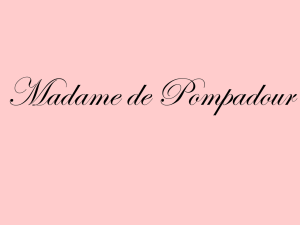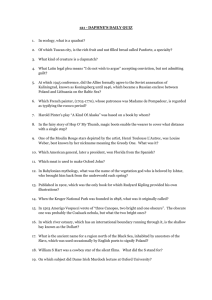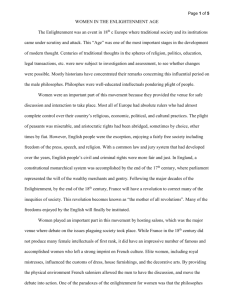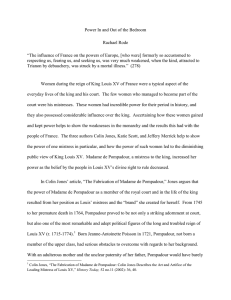File - Rebecca Pena
advertisement
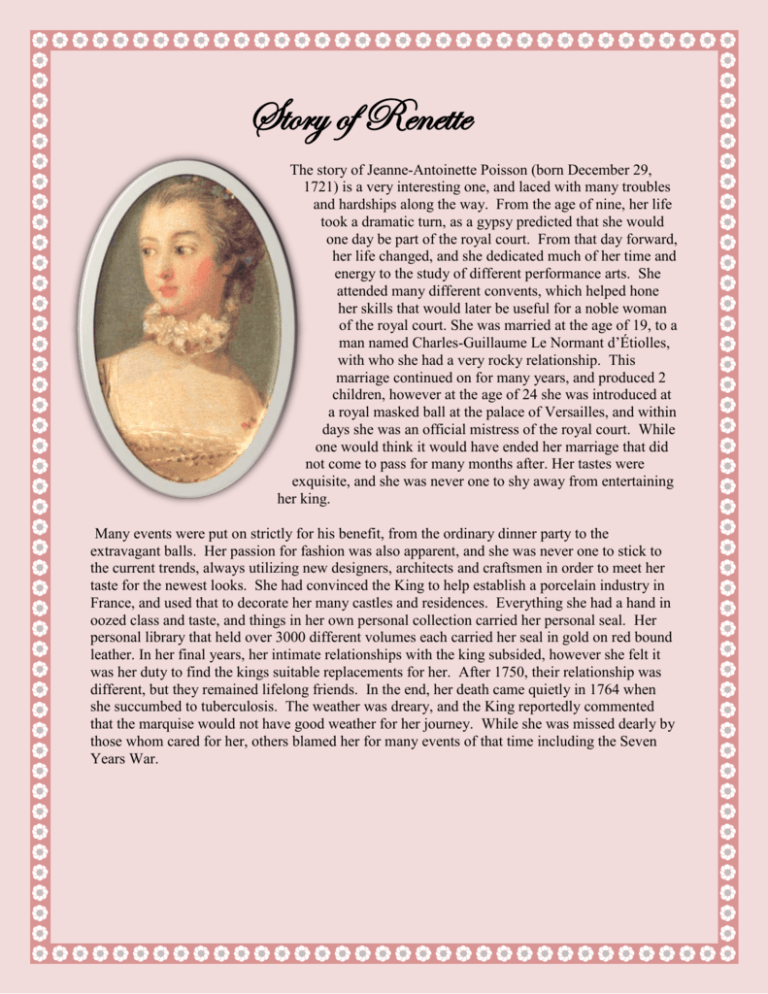
Story of Renette The story of Jeanne-Antoinette Poisson (born December 29, 1721) is a very interesting one, and laced with many troubles and hardships along the way. From the age of nine, her life took a dramatic turn, as a gypsy predicted that she would one day be part of the royal court. From that day forward, her life changed, and she dedicated much of her time and energy to the study of different performance arts. She attended many different convents, which helped hone her skills that would later be useful for a noble woman of the royal court. She was married at the age of 19, to a man named Charles-Guillaume Le Normant d’Étiolles, with who she had a very rocky relationship. This marriage continued on for many years, and produced 2 children, however at the age of 24 she was introduced at a royal masked ball at the palace of Versailles, and within days she was an official mistress of the royal court. While one would think it would have ended her marriage that did not come to pass for many months after. Her tastes were exquisite, and she was never one to shy away from entertaining her king. Many events were put on strictly for his benefit, from the ordinary dinner party to the extravagant balls. Her passion for fashion was also apparent, and she was never one to stick to the current trends, always utilizing new designers, architects and craftsmen in order to meet her taste for the newest looks. She had convinced the King to help establish a porcelain industry in France, and used that to decorate her many castles and residences. Everything she had a hand in oozed class and taste, and things in her own personal collection carried her personal seal. Her personal library that held over 3000 different volumes each carried her seal in gold on red bound leather. In her final years, her intimate relationships with the king subsided, however she felt it was her duty to find the kings suitable replacements for her. After 1750, their relationship was different, but they remained lifelong friends. In the end, her death came quietly in 1764 when she succumbed to tuberculosis. The weather was dreary, and the King reportedly commented that the marquise would not have good weather for her journey. While she was missed dearly by those whom cared for her, others blamed her for many events of that time including the Seven Years War. A peek inside Madame Pompadour’s Closet People have wondered what items Madame Pompadour hid in her closet and now her secret has been revealed. Her collection of garments included a variety of silky corsets, and a strange little contraption called the panier. That device was used to frame a female’s hips, and led to a woman appearing curvier then they already were. Towards the back of her closet it was discovered that she had not worn since her childhood, which was the sacque dress. This dress had a very loose shape, and it hid any waistline that any woman would have. The drama and adventure did not stop there, for as one continued through the century her clothing continued to evolve with her. As her renown and popularity grew, her clothing became more dramatic with the inclusion of Watteau pleats to the back of her gowns. As she considered herself a type of royalty of sorts, the more audacious her dress was the better, but she could dress down for an occasion as well, and those dresses were called robe a la Anglaise. She was not doomed to be bound in uncomfortable dresses forever, for in her latter years, the use of slimmer hoops and fewer frills were embraced known as the polonaise gown. The types that were discovered in her closet were a tad bit mischievous because of the shorter hemlines found in order to show off her ankles. Truly a scandal at this time, she was never one to follow the rules, and heavily embraced the robe a la circassiene. She was an innovator of fashion, and was always at the forefront of accepting and embracing the newest and most risqué of styles. On the other side of the bedroom Men as well, had to look their very best when having a night out on the town, and King Louis XV was no exception. He was never one to shy away from a ruffled frill on his shirt, or an overly feminine jacket. One could say that if you did not look closely you would confuse his dress with that of a woman, because of the similarities they shared. Originally he donned the habit a la francis, which were very long and flowing, but as he aged his tastes matured as did his fashion. He was known to wear in his later years the outer coat known as the frac habille, or an entirely matching ensemble known as the ditto suit. Madame Pompadour’s Journey Through Time Characteristic of style The Sèvres Porcelain There was a certain taste for Chinese style porcelain and a Saxon alchemist discovered the secret of its production and Europe of the 18th century flourished with the manufacturing of these. Madame Pompadour had many castles and places such as summer homes, in which she spent a lot of time on their décor. She was very interested in the decorative arts and encouraged Louis XV to transfer the manufacturing at Sèvres 1756, where it became Royal Manufactory which was the place of the finest china. It was conveniently close to Madame Pompadour’s home and the King’s palace at Versailles. In a few years all royal porcelain was made here and it soon developed and increased its production with table sets and vases. The porcelain production differed for the French because of the lack of the material to make hard paste, instead they used soft paste porcelain being compatible with a variety of colors, allowing glazes to be richer and vivid, these lead to the creation of new colors such as “pink Pompadour” and “Royal blue”. Unglazed porcelain biscuits were also great successes. The King would hold an annual New Year’s Day fair in his private quarters at Versailles so that noblemen bought the porcelain pieces to please him and invest in his monopolized industry. Eyes of the Rococo The colors of the Rococo period were a hot topic by people of all walks of life. The colors that Ms. Pompadour found most attractive were those exhibited in her dressed and accessories, and were documented by her many paintings. These color palettes range from green and blue to light gold and pink. In this period of time however, pink was not a unique color in its own right for it was only seen as a shade of red. This was true for many of the different colors of this time period, as we notice that colors st traditionally seen in the 21 century have different hues and saturation of pigments. This combined with the type of cloth used led to colors appearing softer and more feminine. This also led to many of the garments appearing feminine in general. This fashion however was embraced by Ms. Pompadour and it has been stated that she would not have dressed in any other way, even if she would have had the option of brighter and flashier fabrics at her disposal. Interesting Facts: - She was the first royal mistress from the middle class. All previous royal mistresses had come from the nobility. -The Dauphin called Madame de Pompadour “Mama Putain” which means whore. Obviously, the Dauphin did not like her that much. - At the age of 9 a fortune teller told the young Madame that one day she would be the king’s mistress. - In 1750 her sexual relationship with Louis XV stopped -The king changed her name to match her estate which needed a title -She helped influence the "diplomatic revolution" - 1752: Louis XV made her a duchess -She helped pick out Louis XV's mistresses and kept them in "Stag Park" a room made for them. -In 1752 she moved to the same floor as Louis XV which showed how close her relationship with the king had progressed throughout the years. And her legend lives on… When we were wrapping up our conversation with Ms. Pompadour, I asked her if she thought her name would ever come up again in a few hundred years from now. She responded with an enthusiastic “Yes! Of course, I am not sure how, but I did not work this hard to get where I am today to let my legacy die.” Little did she know how very true that was, her name has been used on all sorts of things, from hairstyles to fine china. Her likeness has also been portrayed many times on the large and small screens, in many different movie and television roles. The King, Louis XV, even managed to commission a cut of diamond so he could always be reminded of her small and delicate mouth. When asked for a reaction to this she simply stated, “It is nothing less than I deserved!” References Tiffany Parce, Vanna McCarthy, Tara McKinney, Rebecca Pena . 1. Spille. Miscellany: Jewels. Retrieved on April 14, 2009, from A bit of everything Web site: http://www.madamedepompadour.com /_eng_pomp/galleria/ditutto/gioielli.htm. 2. Turin, Lorenzo Crivellin. Home, Biography, Bibliography, Costume, The Articles. Retrieved on April 14, 2009, from Madame de Pompadour Web site: http://www.madamedepompadour.com/_eng_pomp/home.htm. 3. Madame de Pompadour. Retrieved from Wikipedia.com Web Site: http://en.wikipedia.o rg/wiki/Madame_Pompadour#Popular_Culture. 4. Baumgarten, Linda. Looking at Eighteeth-Century Clothing. Retrieved from Colonial Williamsburg Web Site: http://www.history.org /history/clothing /intro/index.cfm. 5. Thomas, Pauline Weston. 18th Century Paniers Fashion History. Retrieved on April 14, 2009, from Fashion-Era Web Site: http://www.fashion-era.com/paniers.htm. 6. Vivaldi, Antonio. Part Three. Retrieved April 14, 2009, from Women’s Fashion of the 18th Century Web Site: http://www.marquise.de/en/1700/ womenguide/18guide3.shtml 7. Lowengard, Sarah. The Creation of Color in Eighteenth-Century Europe. Retrieved on April 14, 2009, from Technological Tasks and Philosophical Ideas, interactions between Techniques and Ideas, and Details of Products and Production Web Site: http://www.gutenberg-e.org/ lowengard/index.html. 8. Mitford, Nancy. (1955). Madame de Pompadour. Chapters 1-8. Bungay, Suffolk. In her Heels Madame de’ Pompadour
